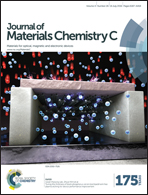A highly stretchable and sensitive strain sensor based on graphene–elastomer composites with a novel double-interconnected network†
Abstract
The construction of a continuous conductive network with a low percolation threshold plays a key role in fabricating a high performance strain sensor. Herein, a highly stretchable and sensitive strain sensor based on binary rubber blend/graphene was fabricated by a simple and effective assembly approach. A novel double-interconnected network composed of compactly continuous graphene conductive networks was designed and constructed using the composites, thereby resulting in an ultralow percolation threshold of 0.3 vol%, approximately 12-fold lower than that of the conventional graphene-based composites with a homogeneously dispersed morphology (4.0 vol%). Near the percolation threshold, the sensors could be stretched in excess of 100% applied strain, and exhibited a high stretchability, sensitivity (gauge factor ∼82.5) and good reproducibility (∼300 cycles) of up to 100% strain under cyclic tensile tests. The proposed strategy provides a novel effective approach for constructing a double-interconnected conductive network using polymer composites, and is very competitive for developing and designing high performance strain sensors.


 Please wait while we load your content...
Please wait while we load your content...